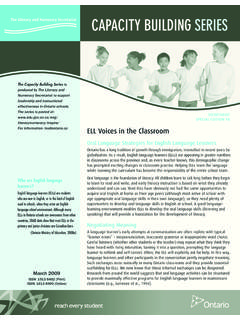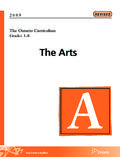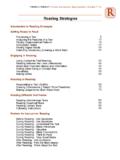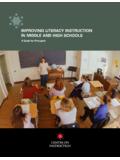Transcription of School Improvement Planning - A Handbook for Principals ...
1 ContentsLetter from the Commissioners ..31. Introduction ..52. What Areas Should Be Considered for Improvement ? ..93. Who Are the Partners in School Improvement Planning ? ..114. How Do We Begin? ..175. How Do We Create a Plan? ..396. How Do We Implement the Plan? ..477. How Do We Evaluate the Results? ..518. How Do We Keep Up the Good Work? ..55 Endnotes ..57 Appendices:Appendix A: School Improvement Planning Project ..59 Appendix B: Sample School Improvement Plan ..61 Appendix C: Characteristics of an Effective principal ..75 Appendix D: Understanding the Expectations and AchievementLevels in the Ministry of Education s Curriculum E: Sample Parent Survey ..85 Appendix F: Sample Text for a Pamphlet That Principals Can Send to Parents with a Copy of Their School sImprovement Plan ..91 Appendix G: Additional Resources ..952 School Improvement Planning HANDBOOKThis Handbook contains several pieces of information, including forms, thatpeople who are developing a School Improvement plan will find useful duringthe Planning process.
2 These items are listed piece of information listed is available as a separate item on the CD-ROMversion of the Handbook as both an HTML and a PDF file. In this print versionof the Handbook , these items are flagged with a CD-ROM icon. The items in the list below that are marked with asterisks (*) are also availableon the CD-ROM in word-processing formats (both Word and WordPerfect) sothat schools may adapt them to their individual needs. Consult the CD-ROMfor more information. (Please note that the CD-ROM may not work on olderMacintosh computers.)Each piece of information is also available as a separate, downloadable itemfrom the Education Improvement Commission s website, items are as follows: Priority for Enhancing Curriculum Delivery (pages 20 to 23) Priority for Improving the School Environment (pages 24 to 31) Priority for Increasing Parental Involvement (pages 31 to 37) * Characteristics of Effective Schools (figure 2, pages 27 to 31) * Types of Parental Involvement (figure 3, pages 35 to 36) * How Do We Involve Parents?
3 (figure 4, page 37) * School Improvement Planning Chart (template for figure 5, page 39) Sample School Improvement Plan (appendix B, pages 61 to 73) Understanding the Expectations and Achievement Levels in the Ministry ofEducation s Curriculum Documents (appendix D, pages 79 to 83) * Sample Parent Survey (appendix E, pages 85 to 90) * Sample Text for a Pamphlet That Principals Can Send to Parents With aCopy of Their School s Improvement Plan (appendix F, pages 91 to 94) The Road Ahead III: A Report on the Role of School Councils(November 1998report of the Education Improvement Commission) The Road Ahead IV: A Report on Improving Schools Through GreaterAccountability(April 2000 report of the Education ImprovementCommission).EDUCATION Improvement COMMISSIONL etter from theCommissionersNovember 2000 The Education Improvement Commission (EIC) is an arm s-length agency ofthe Ontario Ministry of Education. It was created in 1997 to oversee a smoothtransition to a new system of education governance for the publicly fundedelementary and secondary School systems in Ontario.
4 It reports to and makesrecommendations to the Minister of January 1998, School boards in Ontario were reorganized. Seventy-twonew dis-trict School boards were established. Many of the previously existing boardswere amalgamated, some new boards were created, and some boards remainedmuch as they had been before this date. One important outcome of the reor-ganization was the establishment of a new system of French-language boardsthat now spans the entire distinct School board systems now exist in Ontario: English-language district School boards English-language Catholic district School boards French-language district School boards French-language Catholic district School four distinct and equal systems share common goals and responsibilities,while the French-language and Catholic systems simultaneously protect andpromote the cultural, linguistic, and religious values that are central to theirindividual 1999, as part of our mandate, we undertook a progress review of all 72 boardsin the The Road Ahead IV.
5 A Report on Improving SchoolsThrough Greater Accountability, published at the end of the review, we statedour view that the development and implementation of a comprehensiveaccountability framework is the single most important factor that would have thegreatest impact in improving our education system and student achievement. 24 School Improvement Planning HANDBOOK5 EDUCATION Improvement COMMISSIONWe concluded that we need: better information about our students performance better information about the factors that affect this performance, and an increased focus on Improvement Planning at the provincial, board, and an earlier report, The Road Ahead III: A Report on the Role of School Councils, wehad recommended that all schools develop and publish annual School Improvement plans,and that the Planning process include a meaningful role for School councils and contribute to this goal, the Commission worked with 10 schools in the province todevelop and pilot a School Improvement Planning process that includes this experience, we offer this Handbook as a practical, how-to guide to schoolimprovement express our sincere thanks to the Principals , teachers, parents, students, and coor-dinators involved in the pilot projects.
6 They have played a most important part in thedevelopment of this is a large and diverse province. Whatever else a School Improvement planningprocess needs to be, it clearly needs to reflect the unique issues and characteristics of each School community, including the unique needs of the Catholic and French-lan-guage systems. We know that boards, schools, and Improvement Planning teams willwant to modify the material and processes outlined in the Handbook to reflect their owncharacteristics and local encourage these kinds of modifications, confident in the knowledge that improve-ment in student performance is much more likely if schools and their communities setout in an organized, focused, inclusive, and public way to planto hope is that this Handbook represents a significant contribution towards this CookeAnn VanstoneCo-chairCo-chairPeter CameronR mi LessardCommissionerCommissionerBetty Moseley-WilliamsArlene WrightCommissionerCommissionerIntroducti on1 All schools want their students to succeed.
7 But schools can only make alasting difference when they focus onspecific goals and strategies for Improvement Planning is aprocess through which schools set goalsfor Improvement , and make decisionsabout how and when these goals willbe achieved. The ultimate objective ofthe process is to improve studentachievement levels by enhancing theway curriculum is delivered, by creatinga positive environment for learning,and by increasing the degree to whichparents5are involved in their children slearning at School and in the is a School Improvement plan?A School Improvement plan is a roadmap that sets out the changes a schoolneeds to make to improve the level ofstudent achievement, and shows howand when these changes will be Improvement plans are selec-tive: they help Principals , teachers, andschool councils answer the questions What will we focus on now? and What will we leave until later? Theyencourage staff and parents to monitorstudent achievement levels and otherfactors, such as the School environment,that are known to influence studentsuccess.
8 With up-to-date and reliableinformation about how well studentsare performing, schools are better ableto respond to the needs of students,teachers, and School Improvement plan is also amechanism through which the publiccan hold schools accountable for studentsuccess and through which it can measure Improvement . One of the firststeps a crucial one in developing animprovement plan involves teachers, School councils, parents, and othercommunity members working togetherto gather and analyse informationabout the School and its students, sothat they can determine what needs tobe improved in their School . As the planis implemented, schools continue togather this kind of data. By comparingthe new data to the initial informationon which the plan was based, they and the public can measure the suc-cess of their Improvement change takes time. It is importantthat all partners understand this as theyenter into the School improvementplanning process. Incremental improve-ments are significant, and they shouldbe celebrated, but they do not constitutelasting change.
9 School improvement6 School Improvement Planning Handbook plans are therefore best designed asthree-year plans: year 1 is taken up with the planningprocess year 2 is the first year of implemen-tation year 3 is the year in which imple-mentation initial deliberations, or as timegoes on, schools may wish to extendtheir plan for additional years to ensurethat they maintain their focus and reachtheir goals. In any case, School improve-ment plans should be considered work-ing documents that schools use to monitor their progress over time and to make revisions when necessary toensure that the plans stay on developing their School s improve-ment plan, the principal , staff, schoolcouncil, parents, and other communitymembers work through a variety ofactivities focused on three areas of priority: curriculum delivery, schoolenvironment, and parental each of these areas, schools establishthe following: a goal statement performance targets areas of focus implementation strategies indicators of success time lines responsibility for implementingstrategies checkpoints for status updates opportunities for B contains a sample schoolimprovement this handbookFor School Improvement Planning to be successful, it must involve all schoolpartners.
10 When we refer to schools in this Handbook ( schools should .. ),we mean the entire School principal , as the person responsiblefor administering the School and forproviding instructional leadership, isultimately responsible for improvementplanning. But the entire School commu-nity should be actively involved in allstages of the process: Planning , imple-menting, monitoring, and evaluatingprogress. We have therefore written this Handbook for Principals , teachers, School councils, parents, and othercommunity members who participatein the Handbook is intended to be a prac-tical guide for schools that are alreadyinvolved in the Improvement planningprocess, as well as those that are justbeginning. Chapters 2 and 3 describethe areas that should be considered forimprovement and the roles that variouspartners can play in making the processa success. Chapters 4 through 8 outlinestep-by-step activities that help schoolsdevelop their first School improvementplan, implement it, evaluate its success,and revise it to ensure continuousimprovement.















